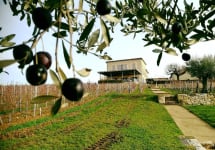Tour Saint Christophe 2016
-
James
Suckling -
Robert
Parker -
Jeb
Dunnuck -
Wine
Spectator



Product Details
Your Rating
Somm Note
Winemaker Notes
"Sensual bouquet of blackcurrant and black cherry aromas. Medium-bodied, with soft and supple tannins, the new wood is perfectly integrated. Nice intensity, nice length and depth with an enticing salinity. The wine perfectly illustrates the purity of the great terroir of Château Tour Saint Christophe. Blend: 80% Merlot, 20% Cabernet Franc"
Professional Ratings
-
James Suckling
This has a rich and ripe dark-fruit nose with a wealth of stony attraction and a lighter, floral edge. The palate has a very rich core of deeply ripe, fleshy fruit, framed in cedary oak. Really impressive clarity and web-like tannins. Superb finish. Try from 2023.
-
Robert Parker's Wine Advocate
The 2016 Tour Saint-Christophe is made up of 80% Merlot and 20% Cabernet Franc. It was aged in 40% new, 40% one-year-old and 20% two-year-old oak for 18 months. Medium to deep garnet-purple colored, it sings of roses, chocolate-covered cherries, redcurrant jelly and cinnamon stick with touches of cigar box and forest floor. Big, full-bodied and richly fruited yet with great tension, it has a compellingly perfumed palate and gorgeous velvety texture with great persistence.
-
Jeb Dunnuck
This incredibly beautiful estate was purchased by Peter Kwok, a Hong Kong-based financier, in 2012. The estate covers a tiny 6.5 hectares (some terraced) just down from Château Barde-Haut, and it remains one of the hidden gems in just about every vintage. The 2016 Château Tour Saint Christophe is another winner. Composed of 80% Merlot and 20% Cabernet Franc that spent 18 months in 40% new French oak, this concentrated, structured 2016 is one for the cellar. It offers a deep ruby/purple color and a powerful array of black fruits, graphite, and earthy minerality as well as a hint of salinity and spring flowers. It has fine tannins (but plenty of them), beautiful balance, and a straight, focused texture, all pointing to the cellar being your friend. Hide bottles of 4-5 years and enjoy over the following 15-20. Tasted twice.
-
Wine Spectator
This is filled with dark, juicy black currant and blackberry preserve flavors laced liberally with bramble and wood spice accents. The fruit kicks into a second gear through the finish, where a roasted apple wood note adds texture and more energy. Rock-solid. Best from 2021 through 2030.
Other Vintages
2024-
James
Suckling -
Robert
Parker - Vinous
-
James
Suckling -
Jeb
Dunnuck - Decanter
-
Robert
Parker - Vinous
-
James
Suckling -
Jeb
Dunnuck - Decanter
-
Robert
Parker
- Vinous
-
James
Suckling -
Robert
Parker - Decanter
-
Jeb
Dunnuck
-
James
Suckling - Decanter
- Vinous
-
Jeb
Dunnuck -
Robert
Parker
-
James
Suckling -
Jeb
Dunnuck -
Robert
Parker - Decanter
-
Jeb
Dunnuck -
James
Suckling -
Robert
Parker
-
James
Suckling -
Jeb
Dunnuck -
Wine
Enthusiast -
Robert
Parker
-
James
Suckling -
Robert
Parker
-
James
Suckling -
Robert
Parker

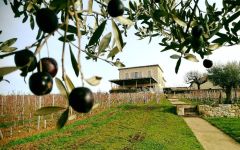
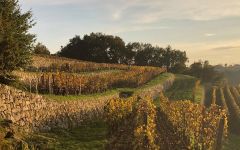
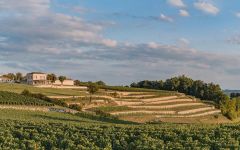
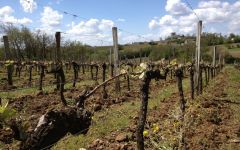
The Chateau overlooks beautiful dry stone terraces several hundred years old on a chalky-clay terroir. The vineyard is planted on this plateau where it has optimal sunlight and perfect natural drainage. The average age of the vines are thirty years old, they flourish and reach perfection in a limestone clay soil enhanced with sedimentary fragments of flint and chalk. It's this secret alchemy which makes the quality of our 'terroir'.
Aware of the richness of the legacy of the past and to preserve it, they undertook to restore Chateau Tour Saint Christophe. The objective was to revive the vineyard terraces with the disassembling and the reconstruction of this dry stone equipment as it had been built in the 18th century. About 1.5 km of dry-stone terraces have been renovated by re-shaping each stone by hand. A titanic work to preserve the original appearance of these unique terraces in Saint-Emilion.

One of the world’s most classic and popular styles of red wine, Bordeaux-inspired blends have spread from their homeland in France to nearly every corner of the New World. Typically based on either Cabernet Sauvignon or Merlot and supported by Cabernet Franc, Malbec and Petit Verdot, the best of these are densely hued, fragrant, full of fruit and boast a structure that begs for cellar time. Somm Secret—Blends from Bordeaux are generally earthier compared to those from the New World, which tend to be fruit-dominant.

Marked by its historic fortified village—perhaps the prettiest in all of Bordeaux, the St-Émilion appellation, along with its neighboring village of Pomerol, are leaders in quality on the Right Bank of Bordeaux. These Merlot-dominant red wines (complemented by various amounts of Cabernet Franc and/or Cabernet Sauvignon) remain some of the most admired and collected wines of the world.
St-Émilion has the longest history in wine production in Bordeaux—longer than the Left Bank—dating back to an 8th century monk named Saint Émilion who became a hermit in one of the many limestone caves scattered throughout the area.
Today St-Émilion is made up of hundreds of independent farmers dedicated to the same thing: growing Merlot and Cabernet Franc (and tiny amounts of Cabernet Sauvignon). While always roughly the same blend, the wines of St-Émilion vary considerably depending on the soil upon which they are grown—and the soils do vary considerably throughout the region.
The chateaux with the highest classification (Premier Grand Cru Classés) are on gravel-rich soils or steep, clay-limestone hillsides. There are only four given the highest rank, called Premier Grand Cru Classés A (Chateau Cheval Blanc, Ausone, Angélus, Pavie) and 14 are Premier Grand Cru Classés B. Much of the rest of the vineyards in the appellation are on flatter land where the soils are a mix of gravel, sand and alluvial matter.
Great wines from St-Émilion will be deep in color, and might have characteristics of blackberry liqueur, black raspberry, licorice, chocolate, grilled meat, earth or truffles. They will be bold, layered and lush.
